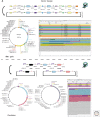Design Automation in Synthetic Biology
- PMID: 28246188
- PMCID: PMC5378053
- DOI: 10.1101/cshperspect.a023978
Design Automation in Synthetic Biology
Abstract
Design automation refers to a category of software tools for designing systems that work together in a workflow for designing, building, testing, and analyzing systems with a target behavior. In synthetic biology, these tools are called bio-design automation (BDA) tools. In this review, we discuss the BDA tools areas-specify, design, build, test, and learn-and introduce the existing software tools designed to solve problems in these areas. We then detail the functionality of some of these tools and show how they can be used together to create the desired behavior of two types of modern synthetic genetic regulatory networks.
Copyright © 2017 Cold Spring Harbor Laboratory Press; all rights reserved.
Figures






Similar articles
-
SynBioSuite: A Tool for Improving the Workflow for Genetic Design and Modeling.ACS Synth Biol. 2023 Mar 17;12(3):892-897. doi: 10.1021/acssynbio.2c00597. Epub 2023 Mar 8. ACS Synth Biol. 2023. PMID: 36888740
-
Engineering genetic circuits: advancements in genetic design automation tools and standards for synthetic biology.Curr Opin Microbiol. 2022 Aug;68:102155. doi: 10.1016/j.mib.2022.102155. Epub 2022 May 16. Curr Opin Microbiol. 2022. PMID: 35588683 Review.
-
Needs and opportunities in bio-design automation: four areas for focus.Curr Opin Chem Biol. 2017 Oct;40:111-118. doi: 10.1016/j.cbpa.2017.08.005. Epub 2017 Sep 15. Curr Opin Chem Biol. 2017. PMID: 28923279 Review.
-
GeNeDA: An Open-Source Workflow for Design Automation of Gene Regulatory Networks Inspired from Microelectronics.J Comput Biol. 2016 Oct;23(10):841-55. doi: 10.1089/cmb.2015.0229. Epub 2016 Jun 20. J Comput Biol. 2016. PMID: 27322846
-
Physical Laboratory Automation in Synthetic Biology.ACS Synth Biol. 2023 Nov 17;12(11):3156-3169. doi: 10.1021/acssynbio.3c00345. Epub 2023 Nov 7. ACS Synth Biol. 2023. PMID: 37935025 Review.
Cited by
-
Cell-machine interfaces for characterizing gene regulatory network dynamics.Curr Opin Syst Biol. 2019 Apr;14:1-8. doi: 10.1016/j.coisb.2019.01.001. Epub 2019 Feb 1. Curr Opin Syst Biol. 2019. PMID: 31579842 Free PMC article.
-
Alternative design strategies to help build the enzymatic retrosynthesis toolbox.RSC Chem Biol. 2022 Sep 13;3(11):1301-1313. doi: 10.1039/d2cb00096b. eCollection 2022 Nov 2. RSC Chem Biol. 2022. PMID: 36349225 Free PMC article.
-
Nobel Turing Challenge: creating the engine for scientific discovery.NPJ Syst Biol Appl. 2021 Jun 18;7(1):29. doi: 10.1038/s41540-021-00189-3. NPJ Syst Biol Appl. 2021. PMID: 34145287 Free PMC article. Review.
-
Automated Design of Robust Genetic Circuits: Structural Variants and Parameter Uncertainty.ACS Synth Biol. 2021 Dec 17;10(12):3316-3329. doi: 10.1021/acssynbio.1c00193. Epub 2021 Nov 22. ACS Synth Biol. 2021. PMID: 34807573 Free PMC article.
-
An electrogenetic toggle switch model.Microb Biotechnol. 2023 Mar;16(3):546-559. doi: 10.1111/1751-7915.14153. Epub 2022 Oct 7. Microb Biotechnol. 2023. PMID: 36207818 Free PMC article.
References
-
- Appleton E, Tao J, Haddock T, Densmore D. 2014a. Interactive assembly algorithms for molecular cloning. Nat Methods 11: 657–662. - PubMed
-
- Appleton E, Tao J, Wheatley FC, Desai DH, Lozanoski TM, Shah PD, Awtry JA, Jin SS, Haddock TL, Densmore DM. 2014b. Owl: Electronic datasheet generator. ACS Synth Biol 3: 966–968. - PubMed
-
- Arkin A. 2008. Setting the standard in synthetic biology. Nat Biotechnol 26: 771–774. - PubMed
Publication types
MeSH terms
Substances
LinkOut - more resources
Full Text Sources
Other Literature Sources
